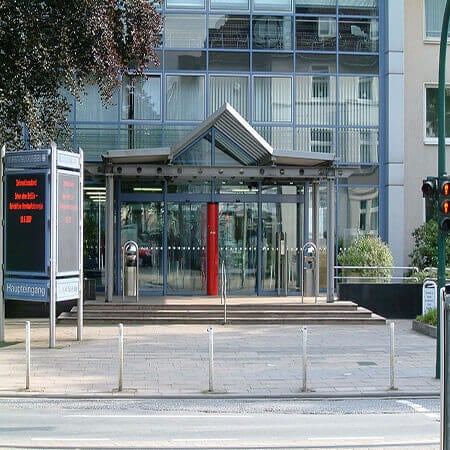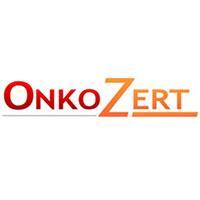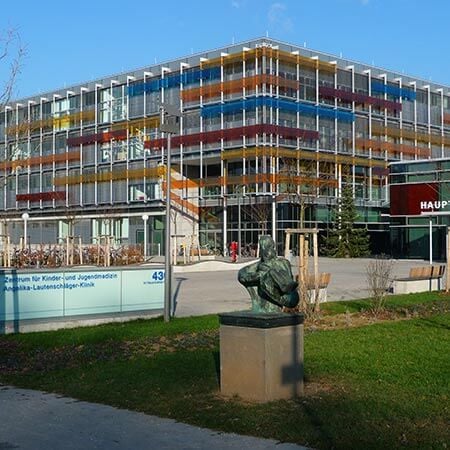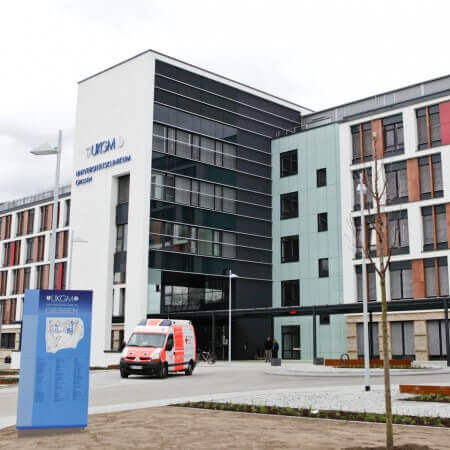Lung Cancer — Proton Therapy: treatment in the Best Hospitals in the World
Treatment prices are regulated by national law of the corresponding countries, but can also include additional hospital coefficients. In order to receive the individual cost calculation, please send us the request and medical records.

Department of Adult and Pediatric Proton Therapy
The Department of Adult and Pediatric Proton Therapy offers the full range of proton treatment and it is one of the leading and most progressive medical facilities of this kind not only in Germany, but throughout the world. The proton therapy is mostly used for the treatment of tumors of the eye, brain, spine and pelvic organs. Also, the proton therapy is an excellent treatment of tumors in children, since it has a minimal negative effect on the immature, sensitive tissues of the child’s body.







National Center for Tumor Diseases (NCT) Heidelberg
The National Center for Tumor Diseases (NCT) Heidelberg offers the full range of diagnostics and treatment of various oncological diseases. Since its foundation in 2004, the center has gained a reputation of one of the leading in Germany. The center is supported by the German Cancer Research Center (DKFZ) and the German Cancer Aid (Deutschen Krebshilfe). The center treats about 60,000 patients from 45 countries every year. Thanks to the outstanding research activities, the department has the very latest therapeutic opportunities that save lives for thousands of people.


Proton Therapy Center
The Proton Therapy Center specializes in an innovative type of radiation therapy for children, namely proton therapy. The medical facility is one of four centers in Germany offering proton therapy for cancer treatment in young patients. The center has been working since October 2015 in close cooperation with the Marburg Ion Beam Therapy Center and today can boast exceptional clinical experience in the field of its competence. Proton therapy is significantly superior to conventional radiation therapy in terms of dose control, dose distribution and side effect profile. Thus, it is an excellent alternative form of cancer treatment. The main advantage of proton therapy is that it has potentially fewer immediate and long-term side effects as compared to classical radiation therapy. The harmful effects on healthy tissues during proton therapy are minimized, which is especially important for children, as their brain and body are in the growth phase. In addition, proton therapy is provided on an outpatient basis and is an absolutely painless treatment, which is also important for young patients.

Lung cancer is the first cause of death from oncopathology in the world. Few patients are candidates for surgery. The main treatment method for most patients is radiation therapy. Photons are usually used as a source of radiation. Doctors abroad also use safer proton irradiation. Not only does it less commonly cause inflammation of the lungs and esophagus, but it also increases the likelihood of cancer cure, as it makes it possible to safely increase the dose of radiation to destroy the tumor.
Content
- Radiation therapy for lung cancer
- Proton therapy instead of photon therapy
- Proton therapy for early stage of lung cancer
- Protons for locally advanced lung cancer
- Benefits of proton therapy for lung cancer
- Treatment in Europe with Booking Health at an affordable price
Radiation therapy for lung cancer
Radiation therapy is the main treatment for locally advanced lung cancer. In addition, it is used at the early stage of the disease, if there are medical contraindications for the surgical intervention or the patient refuses the operation.
Although irradiation is very effective for patients with lung cancer, it is also toxic. The lungs are located next to other organs of the thoracic cavity through which radiation passes. The most common complications are from the esophagus, heart and healthy lung tissue.
With locally advanced lung cancer (stage 3), approximately 60% of patients undergo radiation therapy. It is usually supplemented with chemotherapy. With two methods used at the same time, the five-year survival rate is increased by 4,5% as compared to the sequential use of radiation and chemotherapy. However, this combination of the two treatment methods for lung cancer is more toxic, as it contributes to a high risk of esophagitis, which is an inflammation of the esophagus.
Sometimes chemoradiotherapy can be used for neoadjuvant treatment, namely, prior to surgery. This is possible if at stage 3 cancer the patient is still considered operable, since only a small number of lymph nodes have metastases.
In recent years, many good methods of delivering radiation to organs and tissues have appeared. They are very accurate and relatively safe. IMRT, which stands for intensity modulated radiation therapy, is commonly used for lung cancer. Image-guided radiation therapy is often used as well. Many hospitals use systems that track the patient's chest excursion to target the tumor only during certain phases of breathing.
Nonetheless, curing lung cancer with radiation therapy is a daunting task. The problem is that the curing dose of radiation usually causes complications on the organs exposed: heart, lung, esophagus. Additionally, the risk of severe, including fatal, complications is increased by smoking, old age, and concurrent chemotherapy.
Proton therapy instead of photon therapy
The main method of irradiation of cancer in modern oncology is photon radiation. To deliver radiation, specialists use linear accelerators.
However, photons have one big drawback: they scatter radiation not only inside the tumor, but also along the way to it, and even slightly irradiate the tissues behind the tumor. Doctors have to use multiple angles at which the beams are directed. All these beams converge on the tumor, and it receives the maximum radiation. The amount of healthy irradiated tissue increases, but each area receives a lower dose of radiation, so the risk of side effects is reduced.
Nevertheless, even with this approach, radiation therapy for lung cancer, especially when combined with chemotherapy, is very toxic. Proton therapy for patients with this disease is safer due to the sparing effect on the tissues surrounding the neoplasm. Protons, unlike photons, release most of the radiation only inside the tumor. Thus, the tissues behind the target are not irradiated at all.
For proton therapy, expensive equipment is required. Not every country can offer the services of the proton therapy centers. The number of such centers is small even in developed countries. This is the main reason why protons do not displace photons from oncology.
Proton beam therapy uses one of two technologies: passive scattering and active pencil beam scanning. Passive scattering is a standard method of irradiation, which has been used in medicine for decades. Pencil beam scanning technology is relatively new. It allows the doctors to perform intensity modulated proton therapy (IMPT), making the treatment even safer.
Doctors use high-energy (250 MeV) proton beams with a diameter of about 4 mm for any type of proton therapy. The protons are then scattered to irradiate large and irregular tumors. As a rule, two scatterers are used to change the proton beam.
The new type of proton radiation therapy with pencil scanning technology does not involve the use of some parts that have to be made individually. These are apertures and compensators for the proton beam. As a result, proton therapy is getting cheaper. In addition, IMPT allows the doctors to use several fields with a very inhomogeneous dose to stack them together and to ensure an even distribution of the radiation dose in the tissues. This type of proton therapy is preferable for complex neoplasms located near functionally important structures.
Proton therapy for early stage of lung cancer
Early stages of lung cancer are usually treated with surgery. However, some patients refuse it. Other patients have contraindications for surgery. Radiation therapy for these patients is considered a good alternative and can be conducted using protons.
With the surgical resection of the tumor, the five-year survival rate of patients is estimated by different authors to be 60-80%. The high-quality radiation therapy for lung cancer allows getting comparable results.
As a rule, stereotactic body radiation therapy (SBRT) is used in developed countries to irradiate neoplasms at the first stage of their development. The therapy allows the doctors to deliver large doses of radiation to the tumor in one fraction. Consequently, only a few radiation sessions are required for the patient to destroy the neoplasm. Studies showed that this approach is not inferior in efficiency to conventional irradiation with small doses of radiation for one and a half to two months, but gives fewer complications.
The task of doctors is to use radiation in order to destroy the tumor as completely as possible and to cure the cancer. The greater the dose of radiation delivered to the cancer cells, the higher the likelihood of a cure. The best survival rates are obtained when lung cancer is exposed to radiation doses of 100 Gy and more. However, in this case, the risk of complications increases sharply. The greatest toxicity is typical for patients with tumors more than 5 cm in diameter receiving chemotherapy.
In the case of proton therapy, these problems are reduced. Numerous dosimetric and several clinical studies show the benefits of protons in the treatment of early stage lung cancer.
Their benefits have been proven even in prospective studies. These are studies in which patients are divided into groups before starting treatment. They are considered more reliable than retrospective studies analyzing the results of previous therapy. The first prospective study was carried out in 1999 in Loma Linda. Protons showed less toxicity with high efficiency. The two-year progression-free survival rate was 86%. The second phase of the study, which included additional patients, was carried out in 2013. The patients with lung cancer were irradiated with protons in 10 fractions. As a result, the four-year survival rates increased as the radiation dose was higher. In case of irradiation with a dose of 70 Gy, the survival rate of patients reached 51%, and for patients with peripheral lung cancer the indicator was 60%. Moreover, local control was achieved in 94% of cases. If the tumor developed repeatedly, then the recurrence occurred from metastases.
This study showed the high safety of protons for lung cancer. There were no cases of acute radiation pneumonitis (pneumonia), acute or chronic esophagitis, and cardiac toxicity. In the patients with peripheral lung cancer, there was not even a single toxic reaction of grade 2 or higher.
Very recently, researchers at Anderson Cancer Center and Massachusetts General Hospital, USA, reported their long-term results from a prospective study devoted to protons. They increased the radiation dose to 87,5 Gy. This resulted in improved survival rates with minimal treatment toxicity. After irradiation with protons, the five-year local control of the tumor was retained in 85% of patients. There were no grade 4-5 toxicity reactions, and only one patient had grade 3 toxicity.
Finally, a recent meta-analysis comparing photons and protons for early stage lung cancer has shown clear efficiency benefits of protons. The overall five-year survival rate was 60% for protons and only 41% for photons.
Protons for locally advanced lung cancer
In stage 3 lung cancer, doses of 60-70 Gy are usually used for photon irradiation. Several attempts were made to increase the dose of radiation, but to no avail: the toxicity of the treatment became too high. The main problem is cardiac complications.
However, protons are safer, so the radiation dose can be increased. In the study at the Anderson Cancer Center, doctors delivered 74 Gy to the tumor. Chemotherapy was used at the same time as well. As a result, they got a median survival rate of almost 30 months. The median survival is the period of time after which half of the patients survived. Many of them will live for several more years before lung cancer begins to progress.
Once again, the safety of protons was confirmed. Despite the higher doses of radiation, side effects develop less frequently than in the use of photons. Seipal and colleagues studied toxicity at stage 3 lung cancer patients who received proton irradiation. They compared them to a control group, which received photon irradiation (3D-CRT or IMRT). It turned out that after protons, only 2% developed pneumonitis, and 5% developed esophagitis. For comparison: when using 3D-CRT, 30% of patients suffered from pneumonitis, and 18% from esophagitis. Indicators for IMRT are no better: 9% of patients developed pneumonitis, 44% developed esophagitis. This is despite the fact that the radiation doses when irradiated with photons were lower.
Benefits of proton therapy for lung cancer
A recent analysis of the US National Cancer Database compared treatment outcomes for stage 1 to 4 lung cancer patients who received photon and proton beam radiation therapy. Photon therapy was used much more frequently: 243,822 patients with lung cancer were irradiated using this technique. A total of 348 patients were treated with proton therapy. As it turned out, the use of protons increased the overall five-year survival of patients. It was 16% for photons and 22% for protons. The difference was especially noticeable at the advanced stages of lung cancer: second and third.
To summarize, there are two key advantages of protons over photons:
- Better survival rates of patients, a higher probability of curing cancer due to the possibility of increasing the dose of radiation.
- Lower toxicity of treatment, because even if doctors carry out radiation therapy with protons using higher doses of radiation, the frequency of complications is still several times lower, and sometimes tens of times as compared to photon therapy.
Even large tumors can be safely irradiated with protons. They are better suited for centrally located neoplasms, since higher doses of radiation are needed to successfully suppress them. Protons less irradiate the heart, healthy lung parenchyma, spinal cord and esophagus. This type of radiation therapy not only increases the patient's life expectancy, but also improves its quality. It is better suited for combination with chemotherapy and other drug therapy options, because of its lower toxicity.
You can undergo proton therapy for lung cancer in one of the European hospitals. Modern proton therapy centers use new pencil beam scanning technology. Foreign specialists have extensive and successful experience in the treatment of lung cancer using protons at any stage of the disease.
Treatment in Europe with Booking Health at an affordable price
To undergo proton therapy for lung cancer in one of the European hospitals, please use the services of the Booking Health company. On our website, you can see the cost of treatment in different hospitals, compare prices and book a medical care program at a favorable price. Lung cancer treatment in a European hospital will be easier and faster for you, and the cost of treatment will be lower.
Please leave your request on the Booking Health website. Our employee will contact you and provide a consultation about treatment in Europe. Booking Health will take care of the organization of your trip. We will provide the following benefits for you:
- We will select a hospital for treatment in Europe, whose doctors use proton therapy for lung cancer.
- We will help you overcome the language barrier, establish communication with your attending physician.
- We will reduce the waiting time for the start of the medical care program and book a doctor's appointment on the most suitable dates.
- We will reduce the price. The cost of treatment in European hospitals will be decreased due to the lack of additional coefficients for foreign patients.
- We will take care of all organizational issues: documents for entering the country, transfer from the airport, hotel, interpreting services, etc.
- We will prepare a program and translate medical documents. You do not have to repeat the previously performed diagnostic procedures.
- We will provide communication with the hospital after treatment in Europe.
- We will organize additional diagnostic examinations and treatment in a European hospital, if necessary.
- We will buy medicines abroad and forward them to your native country.
- We will help you keep in touch with the hospital and the doctor after treatment in Europe.
You will receive treatment from the best doctors in the world. The Booking Health employees will help reduce the cost of treatment and take care of all organizational issues, and you will only have to focus on restoring your health.
Authors:
This article was edited by medical experts, board-certified doctors Dr. Nadezhda Ivanisova, and Dr. Bohdan Mykhalniuk. For the treatment of the conditions referred to in the article, you must consult a doctor; the information in the article is not intended for self-medication!
Our editorial policy, which details our commitment to accuracy and transparency, is available here. Click this link to review our policies.

